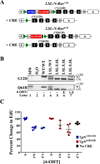Mutation-specific RAS oncogenicity explains NRAS codon 61 selection in melanoma
- PMID: 25252692
- PMCID: PMC4258185
- DOI: 10.1158/2159-8290.CD-14-0729
Mutation-specific RAS oncogenicity explains NRAS codon 61 selection in melanoma
Abstract
NRAS mutation at codons 12, 13, or 61 is associated with transformation; yet, in melanoma, such alterations are nearly exclusive to codon 61. Here, we compared the melanoma susceptibility of an NrasQ61R knock-in allele to similarly designed KrasG12D and NrasG12D alleles. With concomitant p16INK4a inactivation, KrasG12D or NrasQ61R expression efficiently promoted melanoma in vivo, whereas NrasG12D did not. In addition, NrasQ61R mutation potently cooperated with Lkb1/Stk11 loss to induce highly metastatic disease. Functional comparisons of NrasQ61R and NrasG12D revealed little difference in the ability of these proteins to engage PI3K or RAF. Instead, NrasQ61R showed enhanced nucleotide binding, decreased intrinsic GTPase activity, and increased stability when compared with NrasG12D. This work identifies a faithful model of human NRAS-mutant melanoma, and suggests that the increased melanomagenecity of NrasQ61R over NrasG12D is due to heightened abundance of the active, GTP-bound form rather than differences in the engagement of downstream effector pathways.
Significance: This work explains the curious predominance in human melanoma of mutations of codon 61 of NRAS over other oncogenic NRAS mutations. Using conditional "knock-in" mouse models, we show that physiologic expression of NRASQ61R, but not NRASG12D, drives melanoma formation.
©2014 American Association for Cancer Research.
Conflict of interest statement
Figures




References
-
- Adari H, Lowy DR, Willumsen BM, Der CJ, McCormick F. Guanosine triphosphatase activating protein (GAP) interacts with the p21 ras effector binding domain. Science. 1988;240:518–521. - PubMed
-
- Frech M, Darden TA, Pedersen LG, Foley CK, Charifson PS, Anderson MW, et al. Role of glutamine-61 in the hydrolysis of GTP by p21H-ras: an experimental and theoretical study. Biochemistry. 1994;33:3237–3244. - PubMed
-
- Garm Spindler KL, Pallisgaard N, Rasmussen AA, Lindebjerg J, Andersen RF, Cruger D, et al. The importance of KRAS mutations and EGF61A>G polymorphism to the effect of cetuximab and irinotecan in metastatic colorectal cancer. Annals of oncology : official journal of the European Society for Medical Oncology / ESMO. 2009;20:879–884. - PubMed
Publication types
MeSH terms
Substances
Grants and funding
- P30 ES010126/ES/NIEHS NIH HHS/United States
- R01CA163896/CA/NCI NIH HHS/United States
- R00AG036817/AG/NIA NIH HHS/United States
- R01 CA163896/CA/NCI NIH HHS/United States
- R01 CA185353/CA/NCI NIH HHS/United States
- T32ES007126/ES/NIEHS NIH HHS/United States
- R00 AG036817/AG/NIA NIH HHS/United States
- U01 CA141576/CA/NCI NIH HHS/United States
- U01CA141576/CA/NCI NIH HHS/United States
- T32 CA009156/CA/NCI NIH HHS/United States
- T32CA009156/CA/NCI NIH HHS/United States
- T32 ES007126/ES/NIEHS NIH HHS/United States
- P30 CA016086/CA/NCI NIH HHS/United States
LinkOut - more resources
Full Text Sources
Other Literature Sources
Medical
Molecular Biology Databases
Research Materials
Miscellaneous

